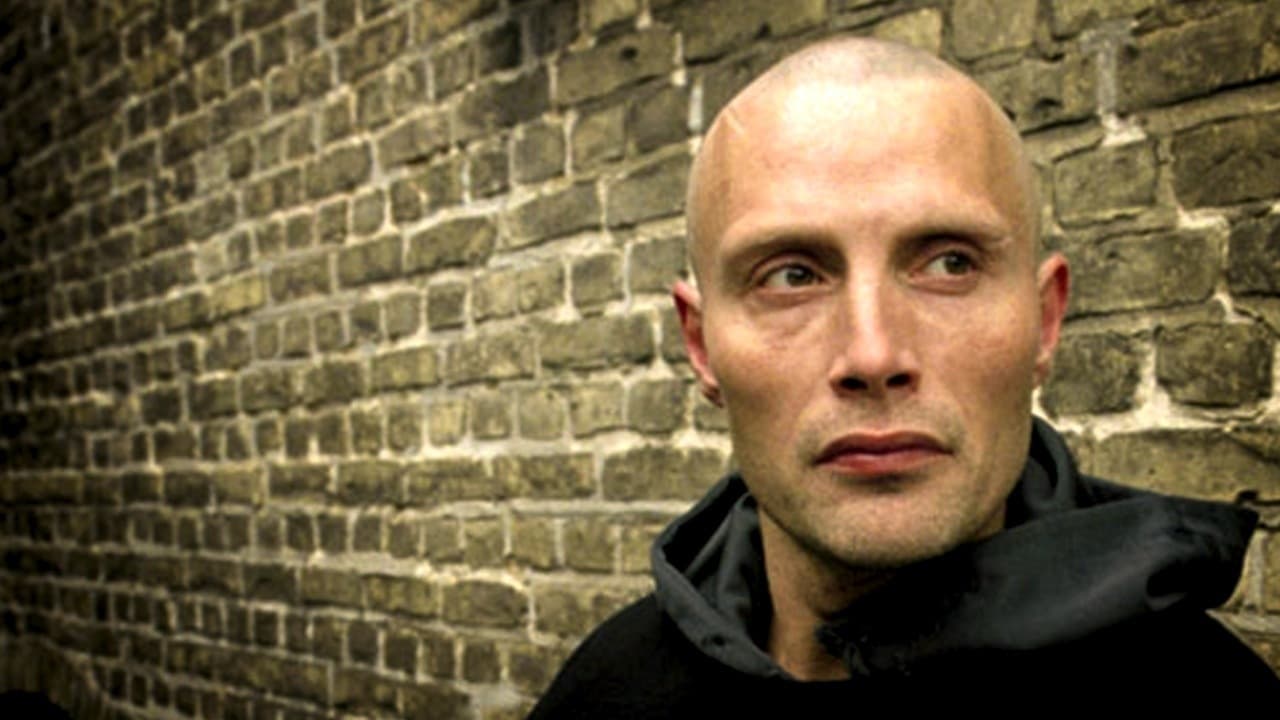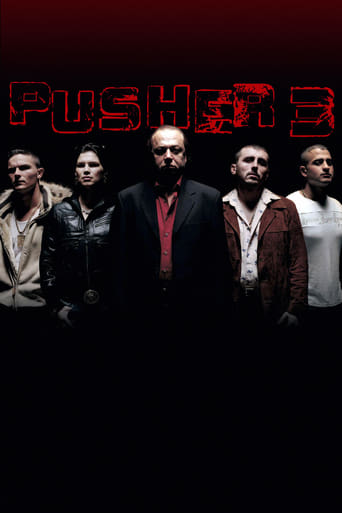

Truly Dreadful Film
... View MorePerfectly adorable
... View MoreNice effects though.
... View MoreJust intense enough to provide a much-needed diversion, just lightweight enough to make you forget about it soon after it’s over. It’s not exactly “good,” per se, but it does what it sets out to do in terms of putting us on edge, which makes it … successful?
... View More"Pusher III" is the final installment of the gritty and often bleak trilogy. The film maintains the conventions so well established thus far - a commitment to realism, subdued plots, and strong characters brought to life by intelligent writing and refined acting. It also maintains the same visual style as established in the first film and improved in the second - a graceful yet documentary-like style of camera-work, coupled with tasteful framing. Like its predecessors, "Pusher III" utilises a character-driven plot, and focuses on the tension surrounding the main character, who is Milo - the drug lord central to Frank's deterioration. At first, this seems like a strange decision, and one that is somewhat hard to take seriously - however, the trilogy's trademark writing, of inferred depth and subtle drama, manages to cast Milo in a light that, as a supporting character in the previous films, we haven't yet seen him in. The film focuses on Milo's struggles with drug addiction, as well as his efforts maintain a balanced family life in the face of his criminal work. Unfortunately, there are two drawbacks regarding plot points that ignite the film's narrative. The first regards the usual subplot of missing or owed money - this section of the film's narrative is initiated, yet again, by a drug bust going faulty. It seems at this point in the trilogy to be a somewhat cheap excuse for implementing tension within the criminal aspects of the plot. However, the decision to initiate this subplot does, in fact, pay off later on in the film. The second drawback is the initiation of the second subplot - Milo's relapse into drug use. This is started when a particularly unlikable character from the second film pays Milo a visit, and whimsically hands over some heroin before leaving. Why he would hand over such an expensive drug to someone he has no plans of reconnecting with is bizarre, accentuated by the fact that this character is never to be seen again - this particular plot point feels like an arbitrary interjection for the sake of kick-starting the suspense within the film. However, once these subplots are started, they work beautifully - they converge into the singular and central plot of the film, focusing on Milo's increased burnout and dependency on substances. We watch him become subordinate to people he dislikes, and lie to his daughter in order to conceal his habits. There is still one more weakness in the sequences of events, in which Milo is moved to kill a Polish pimp. It is not this act itself that is somewhat faulty, but the specific event that spurs this into motion - the pimp's prostitute attempts to escape, and she does so because the pimp momentarily runs to the bathroom to vomit, leaving her free to make a getaway attempt. This feels like yet another arbitrary moment written in for the sake of the plot, yet its snag is minute. While we are on the topic of this particular scene, it's perhaps worth mentioning that, during a moment wherein the Polish pimp pours boiling water over the prostitute's arm, the actress's screams are all too fake - this, too, is only a minor drawback. However, what follows is the film's most rewarding scene - a lengthy sequence involving Milo and his former henchman, familiar from the first "Pusher" film, dispose of the body. This scene involves the men hanging up the body, draining it of blood, and gutting it. This sequence seems all too real, and while it may seem to contribute nothing to the narrative, it is one of the most telling scenes. Throughout the film Milo is depicted as losing more and more self control, culminating in him murdering two men purely out of rage, and it is during the sequence in which the dead Polish man is drawn and gutted that Milo's final mental state is on subtle display. He is careless - helping himself to the victim's watches, almost forgetting to wear gloves, and picking up his coat instead of his apron. Throughout the scene his expression seems blank and pitiless, and it is apparent that he has reached a point of mental defeat - while he still seeks to avoid the reparations of his acts, his demeanour gives the impression of a complete lack of care. Milo has spent the whole film being stressed, and now he is completely burnt out, and sees no desire in stressing any further, and no reason to stress anyway. This isn't, however, a liberating notion in any regard. This demonstrates another element characteristic to the "Pusher" trilogy - of nuanced narrative reinventing. Whereas the first in the series was a crime-thriller, the second film balanced this with the presence of a family-drama. "Pusher III" maintains both these films and instills them with the overarching traits of a psychological-drama. This is accentuated by the use of music - the abrasive rock instrumentals are entirely gone, and are replaced almost entirely by ambient pieces, with the exception of a couple of transgressive industrial pieces. Much like the second "Pusher" film, the music is paired exceptionally well with the visuals and narrative, however it does possess the tendency to lend an easy and perhaps shallow method of displaying visceral, psychological scenes regarding Milo - these scenes will often feature slow-motion shots of the character staring into space, often out of a window, accompanied by an ambient piece. While these scenes are aesthetically meriting, they do little to display what is actually going on in Milo's head. Despite this, the film's narrative manages to pull off its slow-burning approach, and appears to be the most subdued film of the series. Overall, "Pusher III" isn't as strong as its immediate predecessor, but is still a worthy film of the franchise that upholds its defining traits while still pushing the narrative approach in new directions.
... View MoreThis movie was apparently the second sequel to what was by all accounts a fairly popular and well done first edition.I knew none of this when I picked it out of Netflix streaming as a movie from Denmark. Netflix didn't carry the first two more popular movies.It would have been as though a Danish person picked out and watched Psycho IV with out any knowledge of the original Psycho Anthony Perkins or anything else....and Psycho IV had been made with a hand held camera and a budget of $2,000.What I saw were jumpy camera shots of crummy Russian mafia bars and restaurants in Copenhagen. It was the day in the life of an unattractive middle aged drug dealer (Milo) who celebrates his daughter's birthday...gets cheated with some bogus drugs...and to round off the day kills someone manhandling a young girl being sold into prostitution. He then also kills someone who happens in on the murder scene.He and and another Russian thug friend dispose of the two bodies by literally butchering them.The movie did somehow keep your interest more than it should have..not sure if this was because everything about it was so out of mainstream...or there is some quality there I am not recognizing.DO NOT RECOMMEND
... View MoreI frequently visit the IMDb pages of movies I like. I've noticed that Pusher 3 normally oscillates between a 6,6 and 6,9 user rating (very rarely goes over 7). I personally gave it a 10.I have derived a conclusion. There is a wide gap between people who like this movie (in my opinion the best of the trilogy) and people who hate it.And I understand that the love-hate dichotomy can be explained by a simple fact: this movie is too violent. Picture two Yugoslav gangsters in the back of a restaurant, tying a rival to a chair and beginning the questioning with a plastic bag at hand. Then picture the same Yugoslavs (actually a Croat and a Montenegrin) at midnight in a dark basement looking where to plug an electric saw... This is not the typical popcorn movie of a Sunday afternoon.This is how I explain the relatively low rating: there are some who are rating this very high (8,9,10) while some others have left the theatre with an unsavoury taste and are voting accordingly.I liked Pusher 3 because of what the director recreated on the screen. The entire movie is dark in tone. After seeing Milo and his accomplice methodically dispose of two bodies, I felt like I needed to go outside and feel the fresh air, or listen to the current of a flowing river carrying crystalline water, the shades and aroma of green pines in the background.Pusher 3 is a depiction of hell on earth. The underground hell in flames where torture is inflicted by demons doesn't exist: hell is the back of a restaurant, hell is (maybe) the guy who sits next to you in a AA meeting.The movie left me with a bitter taste -and not just because of the violence. Like someone else has commented on this board, there are many unresolved issues (like the warning of the Police to Milo in case Kong of Copenhaguen went missing, or the reaction of Luan upon noticing that his associate Rexho is missing).Paradoxically I think that a proportion of the viewers are still sympathetic to Milo (despite killing at least three persons in the movie and committing a number of other crimes). His defendants will argue that he was under a lot of pressure: from Luan, from Rexho, from her own daughter... The same defendants might go as far as saying that he protected a Polish girl who had been abducted and brought clandestinely into Denmark.On the other hand the prosecutors will cite Milo's continued abuse of drugs, despite his commitments to end it and his visits to AA (or NA). Every time Milo takes drugs there is a before and an after eventually turning into his own Jekyll and Mr. Hyde. To the prosecutors, Milo is a ruthless monster, despite his caring for his daughter and his best intentions to please her.The one thing on which defendants and prosecutors may agree is that Milo is at a crossroads. His influence is waning and his Serbian gang is coming into direct collision with newcomers from also the Balkans (Albanians) and from the Maghreb. His own daughter wants a piece of his turf (if not all of it).
... View MoreI found Pusher Three the best of the trilogy and would strongly disagree with anyone who bashes on this film. Of course, what makes the Pusher movies great is how realistic the scenarios are. Unlike Tarintino, who's dialog is tricky, sometimes too tricky, the Pusher films have simple, believable dialog. Similair to The Sapranos, Pusher III's appeal is seeing the personal life of gangsters. Milo is a chef and restaurant owner but a drug dealer behind the scenes. Its great seeing Milo go back and fourth between preparing a fifty person meal for his daughters 25th Birthday and settling a drug deal in the back room. A great movie that shows you the stress of a gangster trying to maintain his status as a family man. Milo is one of my favorite movie drug dealers. If your not into drugs, you probably won't appreciate all the minor details of the Pusher trilogy.
... View More